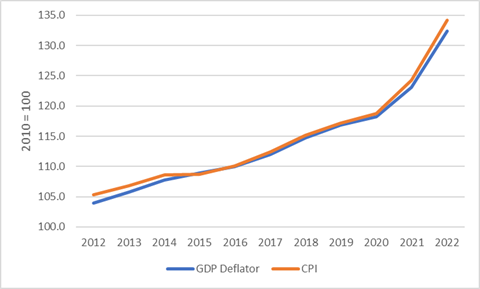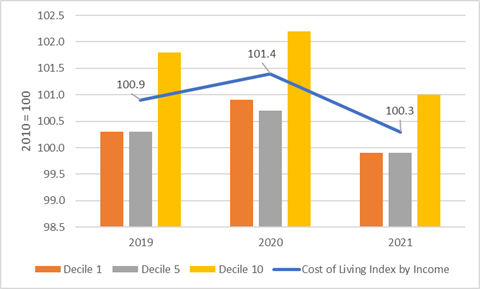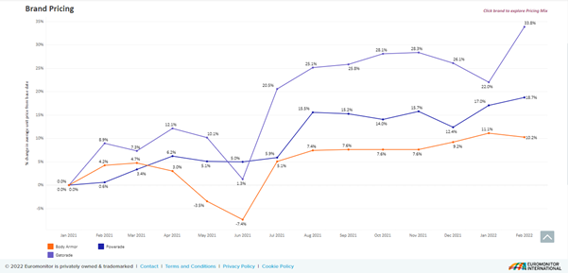Rising prices affect all aspects of the economy and shape market confidence. Inflation can be a positive sign of economic growth or a negative indicator of an overheated market. The inflation surge since 2021 is a result of supply-demand mismatches arising after the COVID-19 pandemic and increasing commodity prices due to the war in Ukraine. Inflation is one economic indicator that defines the actions of governments, companies and consumers. Therefore, tracking inflation leads to better understanding of the economic backdrop of business and consumer markets and to better decision-making.
What is inflation and what causes it?
When demand is higher than supply, producers and service providers can usually raise their prices. This rise in overall price levels is defined as inflation.
Demand-pull inflation occurs when there is a surge in demand and the available supply cannot keep up, which leads to limited availability and consumers who are willing to pay more. As a result, prices increase.
Another type of inflation is cost-push inflation. This type of inflation occurs when prices of products and services increase due to higher production costs for wages, raw materials and commodities.
Government fiscal policies can also affect the inflation rate. Lower taxes, subsidies and benefits, or decreased interest rates lead to higher money supply for businesses and consumers. By having more money, consumers can spend more on goods and services, while businesses can spend it on capital improvement and employee wages.
Three ways to track inflation (GDP Deflator, CPI, PPI)
The most commonly used indicators give a general picture of inflation, while more specific methods reveal a more detailed situation of customers’ habits and how companies are adapting their pricing strategies.
In order to track demand-pull inflation changes, it is possible to look at the overall economy or a specific sector. Overall price change in the economy is tracked by the GDP (Gross Domestic Product) Deflator, which measures the change in prices for all goods and services produced in the country. The GDP Deflator therefore represents a much broader range of goods and services than individual consumer price indices. By tracking this indicator, it is possible to observe how overall economic growth relates to price level changes.
More concentrated price changes are tracked by the CPI (Consumer Price Index), which measures a basket of consumer goods and services most often purchased by households. It also includes imported items that are purchased by consumers.
Usually, the GDP Deflator and CPI will see similar movement, but there are some exceptions that could give different insights. For example, if the price of imported goods increases relative to the price of goods produced in the country, then the CPI will increase faster than the GDP Deflator (eg, US data, below).
Annual GDP Deflator and CPI Changes in the US, 2012-2022

Source: Euromonitor International from national statistics/Eurostat/UN/OECD/ International Monetary Fund (IMF), International Financial Statistics (IFS)
The producer price index (PPI) measures the average change in the price of goods and services either as they leave their place of production or as they enter the production process. PPI is considered to be the measure that reflects cost-push inflation, since it reflects price changes before they reach customers.
In general, the CPI is used to observe how sensitive consumers are to price changes, PPI looks at the inflationary impact at a business level, while the GDP Deflator indicates overall economy sensitivity to prices. Therefore, these indicators can be used separately or as comparison between each other, depending on objectives.
Alternative ways to track inflation (Cost of Living Index, Price and Availability Tracker)
Euromonitor International offers a few alternative ways to track inflation. The Cost of Living Index for each income decile is a unique and more specific measure that indicates how price changes affect different segments of households. While the CPI covers all consumers and highlights general market preferences, our Cost of Living Index shows low and high-income household preferences and how sensitive these segments are to rising prices. The Cost of Living Index is the unique combination of Consumer Expenditure by Income data and Index of Consumer Prices by category data. For example, in the US the cost of living is rising quickly for higher-income households, while in 2020 low-income households saw the highest cost of living increase.
USA Cost of Living Index by Income 2019-2021

Also, more specific price change can be observed using Euromonitor’s granular SKU level (stock keeping unit) e-commerce data. By tracking daily price movements and the availability of tens of millions of product SKUs it is possible to observe how key market players adjust their prices and product assortments due to demand-pull and cost-push causes.

Source: Passport, Soft Drinks Price Tracker
Price changes shift consumer spending and demand, since not all prices and incomes rise proportionately. Businesses change their price policies due to changes in the labour market and surging commodity prices. Governments shape their policies according to price changes too, since they affect employment, grants, tax policies and interest rates. High inflation leads to uncertainty about the future. However, tracking price levels helps to navigate these uncertainties and prepare for future changes.
For more expert insights see our Inflation Surge and Market Research in Action pages.
